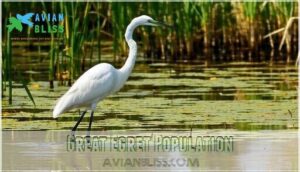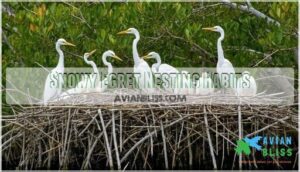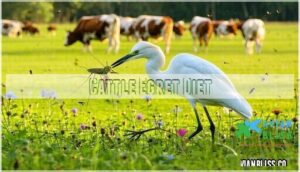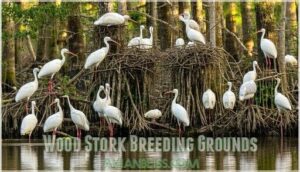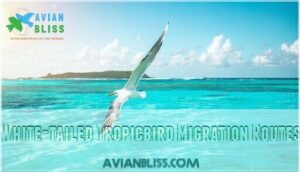This site is supported by our readers. We may earn a commission, at no cost to you, if you purchase through links.
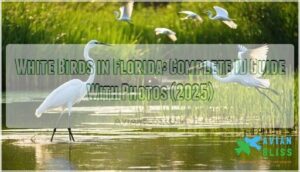
These elegant species thrive in the state’s wetlands, from the Everglades to coastal marshes.
The massive Wood Stork showcases a five-foot wingspan, while delicate Snowy Egrets dance through shallow waters.
American White Pelicans create impressive displays on open water, and the rare Whooping Crane occasionally graces northern regions.
Each species has adapted perfectly to specific habitats – some prefer saltwater coasts, others freshwater swamps, creating exceptional birding opportunities throughout the state.
Table Of Contents
- Key Takeaways
- White Birds Overview
- Florida White Bird Species
- White Birds in Aquatic Habitats
- Large White Birds in Florida
- Rare White Birds in Florida
- Frequently Asked Questions (FAQs)
- What are the white birds in Florida called?
- What is the difference between a white ibis and an egret?
- What are the little white egrets in Florida?
- What white birds visit Florida seasonally?
- How to attract white birds to yards?
- Do white birds mate for life?
- What threats face Florida white birds?
- Where do white birds roost at night?
- Conclusion
Key Takeaways
- You’ll find over a dozen white bird species in Florida, including towering Great Egrets, White Ibis, massive Wood Storks, and rare Whooping Cranes that thrive in diverse wetland habitats from the Everglades to coastal marshes.
- You can identify these birds by their distinctive features – Great Egrets have yellow bills and black legs, White Ibis sport curved orange-red bills, and Snowy Egrets display black bills with bright yellow feet.
- You’ll discover these birds use specialized feeding strategies perfectly adapted to their aquatic environments, from American White Pelicans’ cooperative fishing to Wood Storks’ tactile bill sweeping through sediment.
- You’ll encounter both year-round residents like egrets and seasonal visitors like Snow Geese, with conservation efforts ongoing to protect endangered species like the Whooping Crane that’s recovered from just 15 birds in 1941 to about 180,000 today.
White Birds Overview
You’ll find Florida’s white birds range from the towering endangered Whooping Crane to the delicate Snowy Egret, each species adapted to specific habitats across the state’s diverse wetlands.
Whether you’re spotting a Great Egret’s impressive 6-foot wingspan or watching White Ibis probe mudflats with their curved bills, identifying these birds becomes easier once you know their key characteristics.
This process helps in understanding the birds’ behaviors and habitats, making it a crucial part of identifying these species.
Whooping Crane Characteristics
In North America’s wetlands, you’ll encounter the majestic Whooping Crane (Grus americana), standing as the continent’s tallest bird at five feet.
These endangered white birds florida showcase remarkable characteristics that make bird identification straightforward:
Florida’s majestic white birds display stunning features that make spotting them an unforgettable wildlife experience.
- Crane Size: Towering height with 7.5-foot wingspan
- Crane Plumage: Snowy white feathers with distinctive black wingtips
- Crane Behavior: Loud trumpeting calls and elaborate courtship dances
- Crane Lifespan: Lives 22-24 years with omnivorous Crane Diet
These cranes are endangered, with conservation efforts underway.
Masked Booby Habitat
When you’re searching for the magnificent Masked Booby (Sula dactylatra) in Florida’s coastal waters, you’ll find these seabirds exclusively inhabiting remote islands and keys within the Florida Keys National Marine Sanctuary.
These coastal birds prefer flat, open ground with minimal vegetation for their simple ground-scrape nests.
| Habitat Feature | Preference |
|---|---|
| Nesting Location | Flat, open ground or low vegetation |
| Primary Habitat | Remote islands and keys |
| Foraging Areas | Open ocean waters near colonies |
| Avoided Areas | Heavily forested or urbanized regions |
Their habitat preferences center around coral reefs, sandy beaches, and rocky shores where these impressive seabirds can establish colonies.
Unfortunately, habitat threats including invasive species like rats and cats, plus rising sea levels, challenge booby conservation efforts in Florida’s delicate island ecosystems.
White Ibis Migration Patterns
White Ibis showcase remarkable Seasonal Movements throughout Florida’s wetlands, with migration patterns heavily influenced by Habitat Influence factors.
These wading birds, Florida residents, begin Breeding Migration in late summer, peaking between August and October.
Ibis Tracking studies reveal Climate Impact affects timing, while juveniles follow experienced adults along established routes.
They often forage in wetlands using their long bills.
Florida birdwatching enthusiasts can observe these graceful flocks using thermal currents during their impressive bird migration journeys.
Florida White Bird Species
Florida’s white birds represent some of the state’s most recognizable and abundant wading species, with over a dozen species calling the Sunshine State home year-round.
You’ll find these elegant birds throughout Florida’s diverse wetland habitats, from coastal mangroves to freshwater marshes, with many species maintaining stable populations that make them reliable targets for birdwatchers and nature enthusiasts.
Great Egret Population
Since the early 20th century, Great Egret populations in Florida have experienced dramatic ups and downs.
From near extinction to 180,000 birds today, the Great Egret proves conservation works.
These magnificent white egret florida residents nearly disappeared due to plume hunting but made a remarkable comeback through conservation efforts. However, habitat loss continues threatening breeding success of these iconic wading birds florida.
The egrets have long slender black legs that help them wade in shallow waters. Learn more here.
- Population trends show recovery from 3,000 birds in 1910 to approximately 180,000 today
- Climate impacts and wetland drainage reduced Everglades breeding pairs by 90%
- Herons and egrets remain vulnerable to pollution affecting their aquatic food sources
Snowy Egret Nesting Habits
Three months into spring, Florida’s Snowy Egrets begin their fascinating nesting season.
These elegant white egret florida species form dense colonies in mangroves and salt marshes, creating a bustling community of wading birds florida.
You’ll find their shallow stick nests clustered together, with both parents sharing duties throughout the breeding cycle.
Their nests are often the subject of interest, and you can even find snowy egret nest products online.
| Nesting Aspect | Details |
|---|---|
| Habitat Selection | Mangroves, salt marshes, barrier islands over water |
| Nest Construction | Shallow oval of twigs, 14-18 inches across |
| Breeding Season | March-April in Florida |
| Chick Development | 20-25 days in nest before fledging |
| Parental Care | Both parents incubate eggs and feed young |
Cattle Egret Diet
Cattle egret diet composition reflects their opportunistic foraging behavior, making them adaptable florida birds among white bird species.
These resourceful hunters consume insects stirred up by grazing livestock, showcasing remarkable habitat influence on their feeding patterns.
Their seasonal variation includes:
- Grasshoppers and crickets during summer months
- Flies and beetles around cattle herds
- Frogs and small reptiles in wetland areas
- Spiders and moths during insect consumption peaks
White Birds in Aquatic Habitats
Florida’s aquatic habitats support some of the state’s most impressive white birds, from the massive American White Pelican to the elegant Wood Stork.
You’ll find these species gathered around freshwater lakes, coastal marshes, and tidal flats where they’ve mastered unique feeding strategies perfectly suited to their watery environments.
American White Pelican Feeding Habits
You’ll spot American white pelican flocks working together like a well-oiled team across Florida’s shallow waters.
These massive white birds in florida demonstrate remarkable cooperative hunting strategies, forming synchronized lines to herd fish into concentrated areas where their oversized bill pouch can scoop up multiple prey at once.
| Feeding Aspect | Details | Florida Specifics |
|---|---|---|
| Prey Selection | Fish 3-8 inches long, primarily carp and minnows | Abundant in large lakes and wetlands |
| Cooperative Hunting | Groups of 5-20 birds form feeding lines | Most effective in shallow bays |
| Foraging Locations | Lakes, reservoirs, slow rivers | Everglades and coastal estuaries |
| Seasonal Diet | 90% fish, varies with availability | Peak feeding during winter months |
Wood Stork Breeding Grounds
Wood stork breeding grounds in Florida’s wetland habitats create bustling colonies during nesting season.
These wading birds (Mycteria americana) establish rookeries in cypress swamps and mangroves, where colony size can reach hundreds of pairs.
Conservation efforts focus on protecting these essential sites, as habitat loss threatens chick survival and breeding success for these remarkable birds.
Consider nesting habitat products to support these remarkable birds.
White-tailed Tropicbird Migration Routes
During winter months, you’ll find White-tailed Tropicbirds following the Atlantic Flyway southward from their Caribbean breeding colonies.
These remarkable seabirds demonstrate complex migratory patterns, with oceanic dispersal spanning over 1,000 kilometers between feeding and nesting sites.
As a vital part of their journey, they depend on conserved stopover habitats for rest and refueling.
- Caribbean stopovers provide essential rest points during long-distance flights
- Breeding colonies on tropical islands serve as migration departure points
- Climate impacts increasingly affect traditional flight timing and routes
- Oceanic dispersal patterns follow wind currents for energy conservation
Large White Birds in Florida
When you’re exploring Florida’s waterways and wetlands, you’ll encounter several impressive large white birds that command attention with their size and grace.
The Great Egret stands tallest among common species at over three feet, while the massive American White Pelican boasts a wingspan reaching nearly 10 feet across.
Noteworthy Characteristics of Great Egret
You’ll recognize Great Egret (Ardea alba) by its impressive stature among Florida’s white birds.
This elegant hunter stands four feet tall with striking yellow bill and black legs that distinguish it from smaller egrets.
| Characteristic | Details |
|---|---|
| Size | 32-40 inches long, 55-67 inch wingspan |
| Hunting Style | Patient wading, lightning-fast strikes |
| Plumage | Pure white with breeding plumes on back |
| Social Habits | Solitary feeder, colonial nester |
| Conservation | Recovered from near extinction, now stable |
Range Map of American White Pelican
You’ll find American White Pelican distribution spans across North America’s interior waterways.
These magnificent white birds in florida appear primarily during winter months, with breeding locations concentrated in northern prairie states and western Canada.
Migration patterns bring them south to Florida’s coastal areas and inland lakes.
Unfortunately, habitat loss threatens traditional nesting sites, making conservation efforts vital for maintaining stable populations throughout their range.
These birds use thermals for efficient flight during migration, which is crucial for their survival, highlighting the importance of preserving natural habitats.
Identifying White Birds in Flight
When observing white birds in florida during flight, you’ll notice distinct flight patterns that aid bird identification florida.
Great Egrets display slow, deliberate wingbeats with necks folded back, while American White Pelicans soar in V-formations at higher altitudes.
Speed variation helps distinguish species – Snowy Egrets fly faster with quicker wingbeats than their larger cousins.
Silhouette identification becomes essential as altitude impact affects visibility. Flock behavior also provides clues for accurate identification.
Observing egret aerial dynamics can further refine species recognition.
Rare White Birds in Florida
You’ll encounter some truly special white birds in Florida that are either endangered or uncommon visitors to the state.
From the critically endangered Whooping Crane with its distinctive red crown to the occasional Snow Goose passing through during migration, these rare sightings make every birdwatching trip an exciting adventure.
Whooping Crane Conservation Status
The Whooping Crane stands as North America’s most celebrated endangered species comeback story, though its conservation status remains precarious.
Once numbering over 10,000 birds historically, the population crashed to just 15 individuals by 1941 before intensive conservation efforts began reversing this devastating decline.
- Captive breeding programs have successfully increased genetic diversity while providing insurance populations for future reintroduction efforts
- Crane recovery plans involve international collaboration between U.S. and Canadian agencies to protect critical breeding and wintering habitats
- Public awareness efforts have transformed this species into a conservation icon, generating widespread support for avian conservation initiatives nationwide
White Ibis Unique Features
You’ll spot White Ibis (Eudocimus albus) by their distinctive curved bills, perfectly designed for probing mud and shallow water.
These white birds in florida showcase remarkable Ibis social behavior, often feeding in mixed flocks.
Their Ibis plumage changes dramatically from juvenile brown to adult white.
Listen for their soft grunting Ibis vocalizations during foraging techniques that involve tactile bill sweeping through sediment.
Snow Goose White Morph Characteristics
Snow geese showcase remarkable plumage variations that make them fascinating subjects for bird identification enthusiasts. These Arctic visitors display distinct genetic factors that produce their striking white morph, contrasting dramatically with their blue morph relatives through complex hybridization patterns.
During Florida’s winter months, you’ll recognize Snow Goose (Anser caerulescens) white morphs by these key characteristics:
- Pure white body plumage with contrasting black primary wing feathers that create dramatic wingtip patterns
- Pink bill with distinctive black "grinning patch" – a vital bill morphology feature for positive identification
- Pink legs and feet that complement the overall color scheme and aid in field recognition
- Medium-large size measuring 27-33 inches with impressive wingspans reaching 4.25-5.5 feet
These white birds in florida represent exceptional wintering ecology adaptations. Their mainly white plumage, evolved for Arctic camouflage, makes them stand out against Florida’s diverse landscapes. Habitat loss represents significant threats to these and other bird species. The genetic factors controlling their coloration allow free interbreeding between white and blue morphs, creating fascinating hybridization patterns that demonstrate nature’s complexity in bird characteristics.
Frequently Asked Questions (FAQs)
What are the white birds in Florida called?
You’ll find Great Egrets, Snowy Egrets, White Ibis, American White Pelicans, and Wood Storks across Florida’s wetlands.
These magnificent birds share similar habitats but display distinct characteristics in size and feeding behaviors, making them a unique sight in their wetlands.
What is the difference between a white ibis and an egret?
You can distinguish white ibis from egrets by their curved orange-red bills versus egrets’ straight yellow bills, plus ibis have pinkish legs while egrets sport black legs.
What are the little white egrets in Florida?
You’ll encounter two main little white egrets in Florida: the Snowy Egret and Cattle Egret.
Snowy Egrets have black bills with bright yellow feet, while Cattle Egrets sport yellow bills and dark legs.
What white birds visit Florida seasonally?
While year-round residents like egrets grace Florida’s wetlands constantly, seasonal visitors create striking contrasts.
You’ll spot Snow Geese during winter months, along with migrating gulls and terns that transform Florida’s coastlines into temporary white-feathered sanctuaries.
How to attract white birds to yards?
Create shallow water features, plant native fruiting trees, and provide open nesting platforms.
White birds like egrets and ibises prefer accessible water sources, berry-producing plants, and elevated perching spots for safety and feeding opportunities.
Do white birds mate for life?
Love’s forever bond isn’t universal among white birds.
You’ll find some species like whooping cranes typically mate for life, while others like egrets and ibises often choose new partners each breeding season, depending on survival and availability.
What threats face Florida white birds?
You’ll find Florida’s white birds facing habitat loss from coastal development, pollution contaminating their wetlands, climate change disrupting nesting sites, and collisions with buildings during migration flights.
Where do white birds roost at night?
Like silent ghosts seeking shelter, you’ll find these feathered spirits gathering in protected roosts.
They choose mangrove islands, cypress swamps, and coastal marshes where predators can’t reach them easily at night, which can be considered protected areas.
Conclusion
Discovering these magnificent white birds in Florida transforms any nature enthusiast into a devoted birder.
You’ll find that patience and proper identification skills reveal incredible wildlife experiences across the state’s diverse ecosystems.
Whether you’re exploring coastal marshes or inland wetlands, these elegant species offer year-round viewing opportunities.
Remember to bring binoculars and respect nesting areas while observing these remarkable creatures.
Your next adventure awaits among Florida’s most stunning white birds in their natural habitats.

